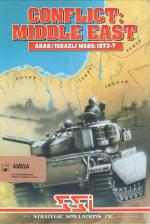
Amiga Power
 1st September 1991
1st September 1991
Categories: Review: Software
Author: Sean Masterson
Publisher: Strategic Simulations Inc
Machine: Amiga 500
Published in Amiga Power #5
Conflict Middle East
No problem guessing what this one's all about really, is there? The game's subtitle speaks volumes - 'Arab-Israeli Wars: 1973-?' In fact, the question mark is sort of irrelevant now - real-life events in the Middle East have already grimly overtaken the game's Operation Desert Storm 'contemporary' scenario.
Really aside though, how does this work as a wargame? Well, for a start you must remember that wargames are what designers at SSI have traditionally been best at, and Conflict Middle Easy represents pretty much the state-of-the-art in that particular branch of gaming. The problem isn't really with the game itself so much as with whether what passes for 'state-of-the-art' in wargaming terms is really good enough any more.
But first, how does it work? Well, pretty much in traditional wargame terms. Units are displayed as icons on a hexagonally patterned terrain map and movement and combat are handled in a series of controlled phases which make up a turn. You can play either against the computer or a human opponent, take either side, play out battles from the '73 or '90s war, pick the time of year and go for complete or limited intelligence. If you're playing on your own you can choose to alter the opposition's effectiveness.
One thing soon becomes clear - logistics, not just combat, are essential to grasp if you want to nick some Sinai while nobody's looking. The most important thing to remember is not to over-reach yourself. Supply nets try to keep your frontline troops stocked up with fuel and ammunition as best they can, but if you stretch them too far you'll soon start losing your front line armour en masse.
Don't fret though - it's not too complicated. Remember, in a game like this it's perfectly acceptable to take your time with things. Time only passes when you tell it to - either by ending a turn or carrying out actions in a turn. This gives you the chance to skim the manual between moves (and thankfully, it's a clear and easy one to read). To start with, I was confused to find that airnorne cavalry units are identified as artillery units (because that's what they're most like in effect), but a quick flick through the manual and I'd worked out what was going on.
But back to my point about the validity or not of traditional wargames. This is without doubt a clever one - something as simple as the weather can hamper crucial air strikes - but although I'm still making progress, I reckon I'll soon be able to defeat anything the program throws at me, and then the game will only be brought out when there's a chance that the company I keep fancies a bash.
Wargames have been moving closer to simulations territory recently and I think they've been better for it. With stuff like M1 Tank Platoon, you get more of the feel of playing a 1/300th scale micro armour game - even as seen from the tabletop which is ideal. Playing the redundant 1990s scenario, I couldn't help feel that Conflict Middle East is already something of an anachronism. Historically, it's a fine wargame. But in style and subject, it has little to offer those interested in what might unfold in another Middle East military crisis. Real wargamers have moved on.
The Bottom Line
A fine traditional wargame, but it's a form that looks increasingly left behind by the more sophisticated wargame techniques now in use.
Scores
Amiga 500 Version| Overall | 68% |




